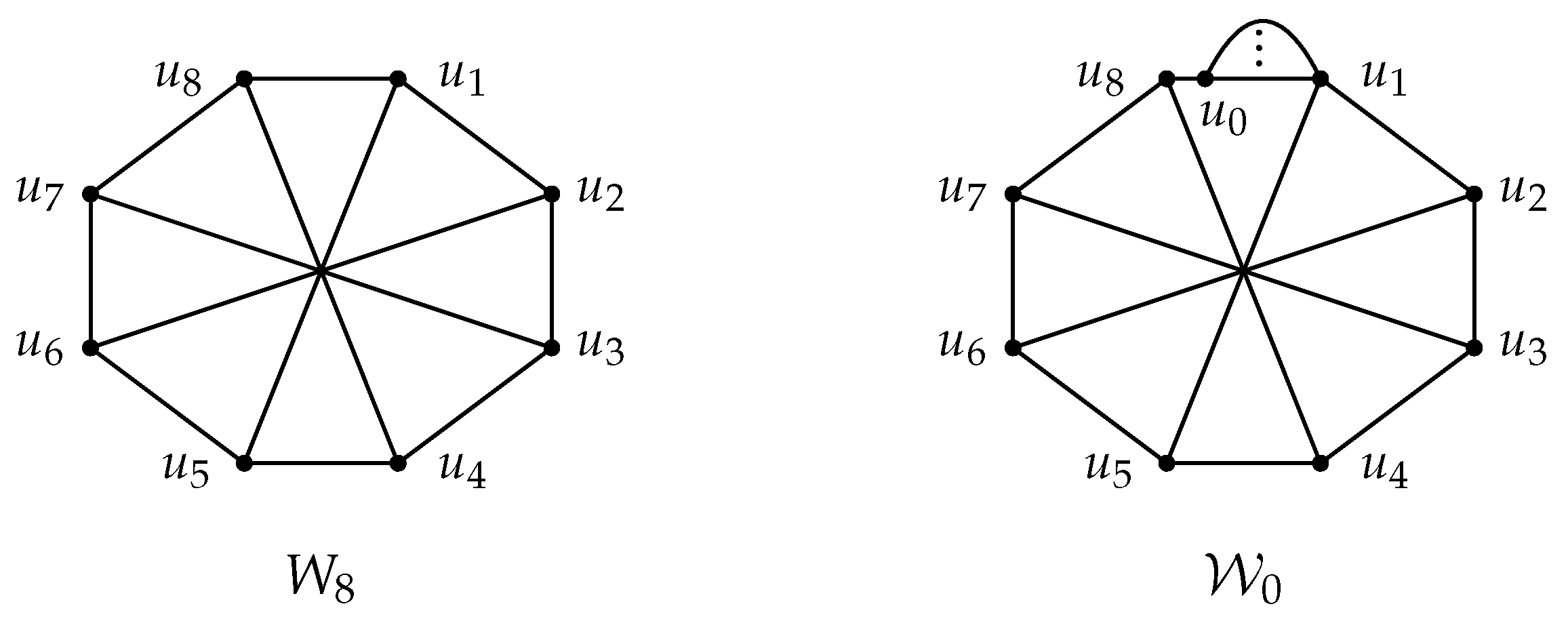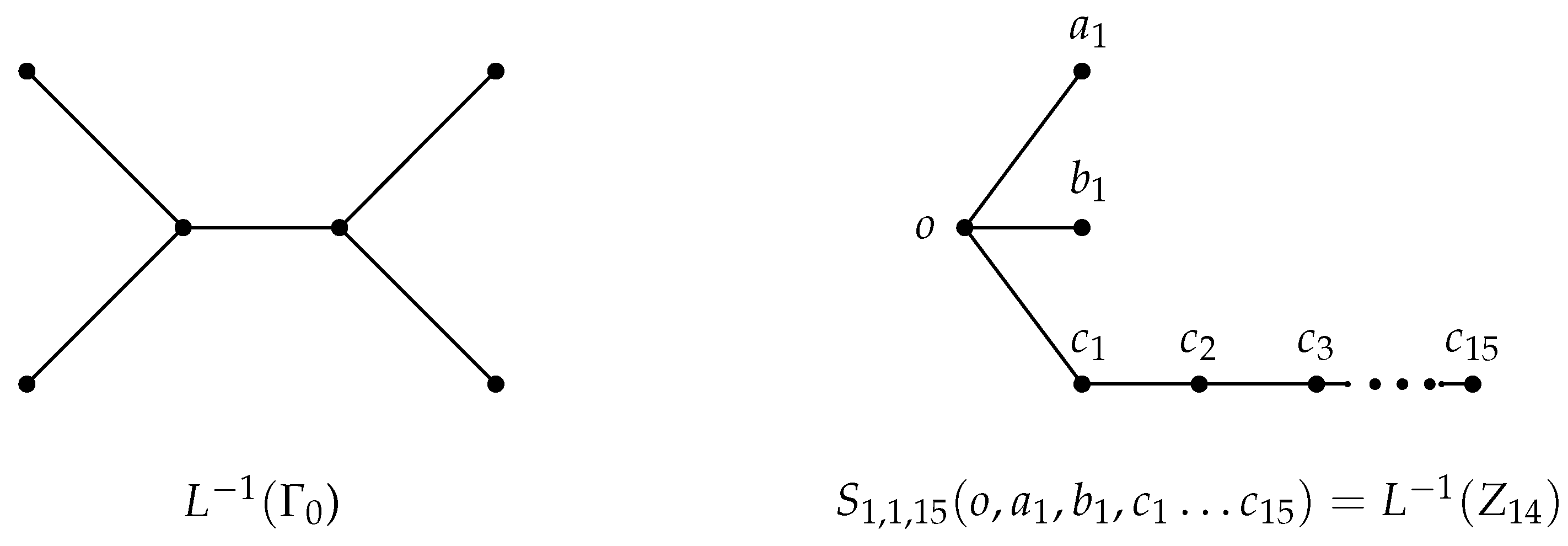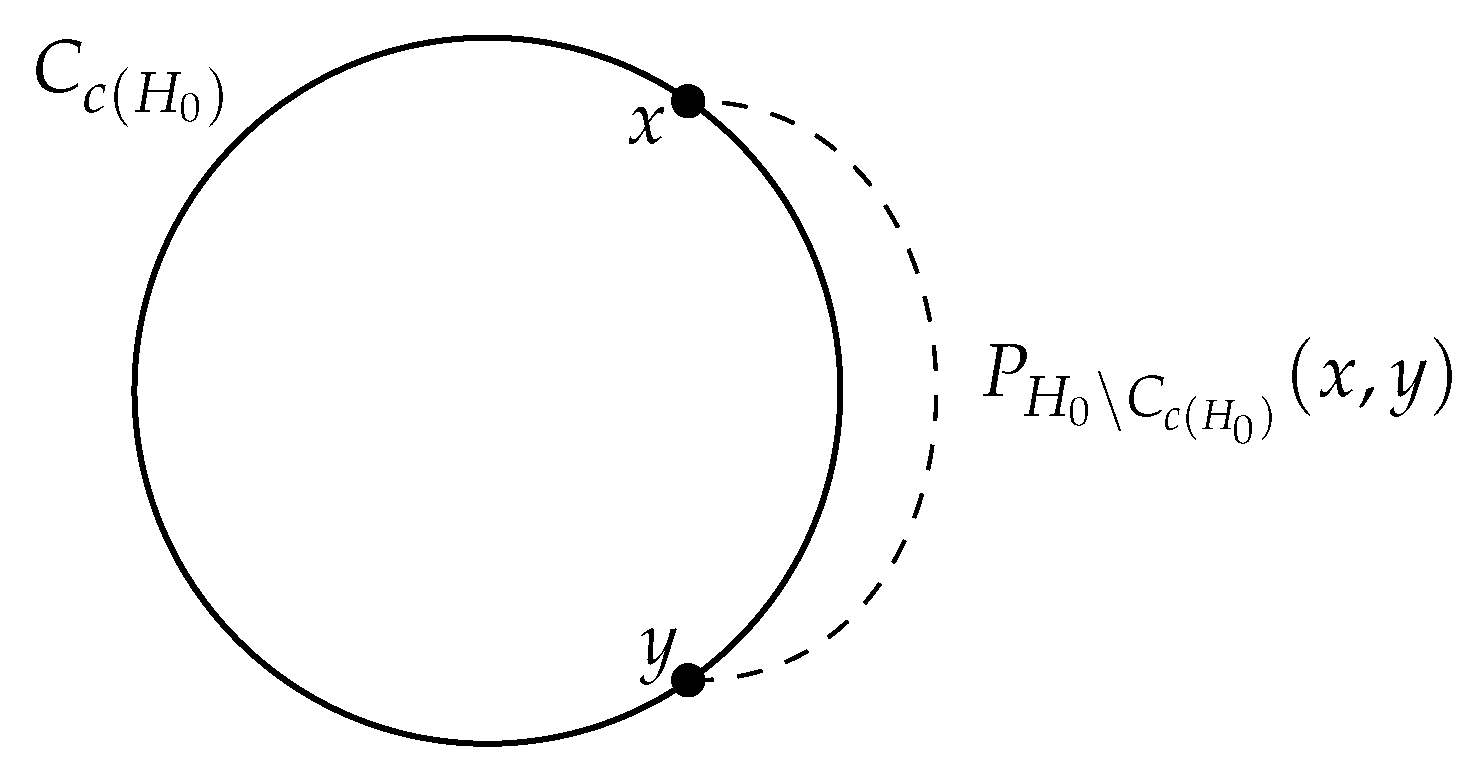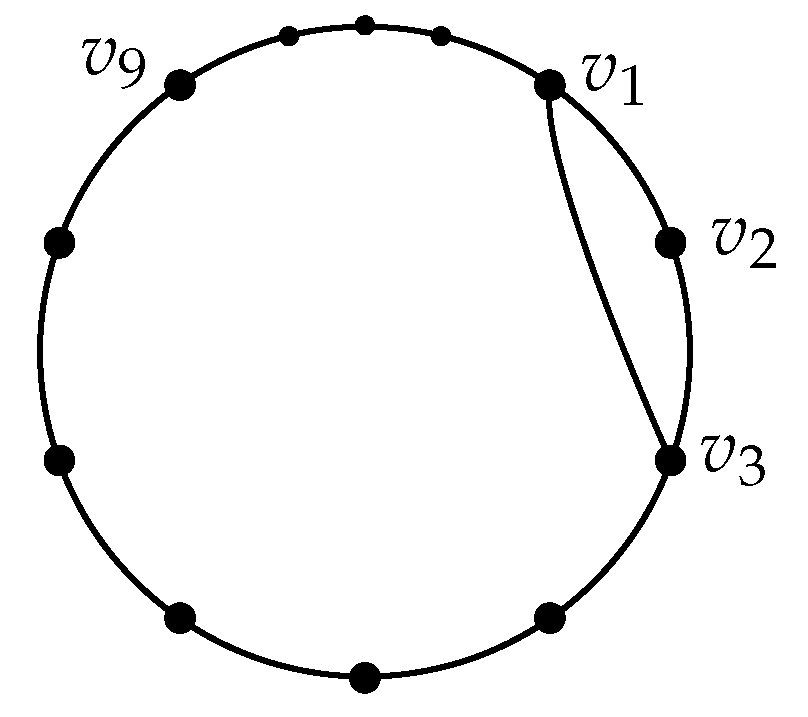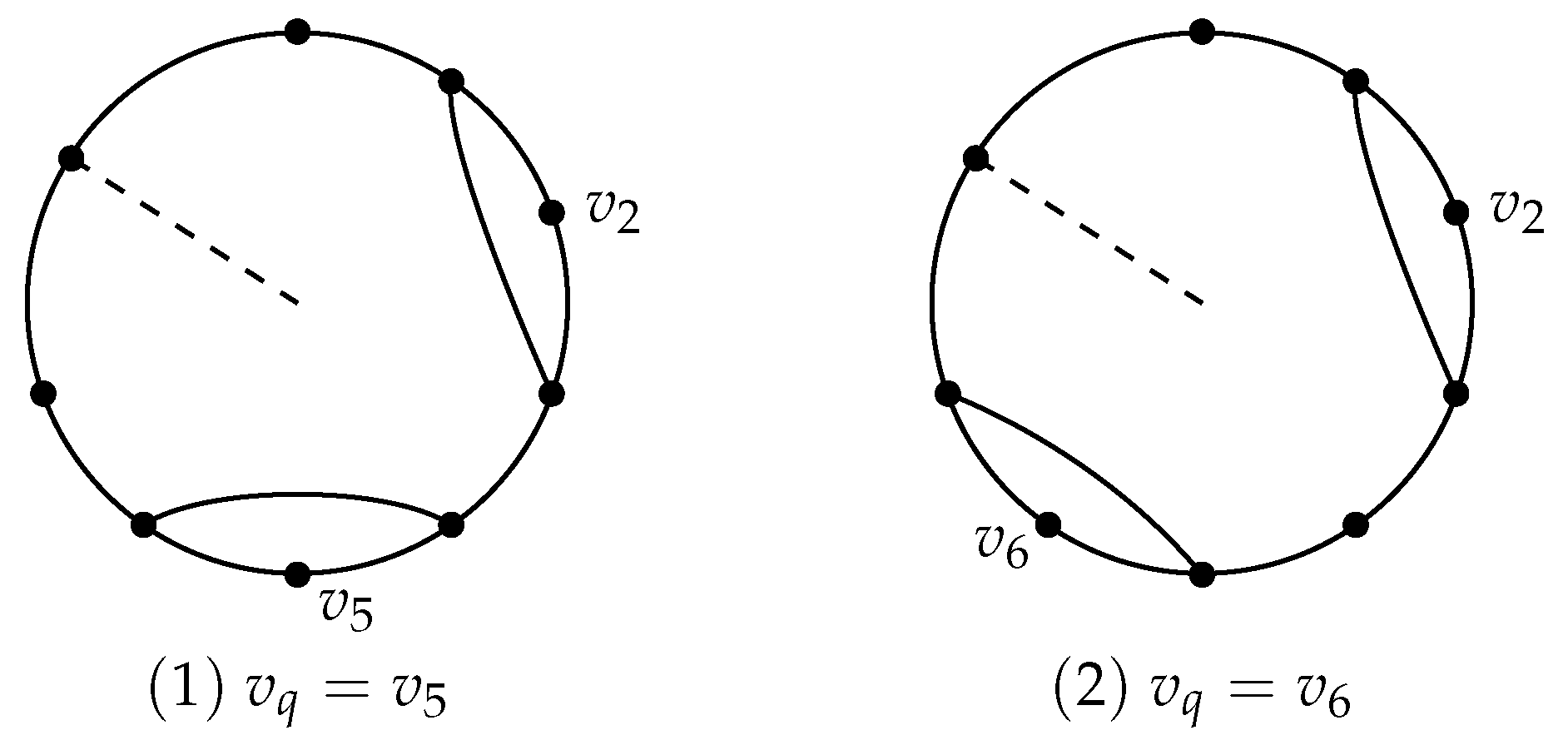1. Introduction
In this paper, for some undefined concepts, please refer to [
1].The next part introduces common graph theory symbols and terminology. A graph always refers to a finite undirected simple graph, and is denoted by
; if
multiedges (where at least two edges in an induced subgraph have the same pair of end vertices) are allowed, then the graph
G is called a
multigraph. If a graph
G does not have an induced subgraph that is the same as the sets of vertices and edges of
F, then it is called an
F-free graph.
is a cycle with a number of edges and edges
i, and
is a path with a number of vertices
i. We use
to denote the neighborhood of the vertex
v in
G, and the degree
of a vertex
v denotes the number of elements of
. We denote the neighborhood and the degree of a vertex
v in
G with
and
, respectively. For simplicity, we can remove the subscript with
G in this paper, e.g., we will write
as
. We use
and
to represent the maximum and the minimum degrees of a graph
G, respectively.
Given a subgraph
H of
G, if the vertex set of
H is the vertex set of
G, then
H is a
spanning subgraph of
G. Given the definition of a spanning subgraph, if
G has a spanning cycle, then
G is also
Hamiltonian; for any pair vertices of
G, there exists a spanning path with them as end vertices, and the graph
G is
Hamilton-connected. It is a difficult, well-studied, and meaningful problem to determine whether a graph is Hamilton-connected. They are central to graph theory. Some forbidden subgraphs used in this paper are shown in
Figure 1. Theorem 1 lists known results on the Hamilton-connectedness of the forbidden subgraph pairs of the 3-connected graph.
Theorem 1. Let G be -free and a 3-connected graph. Then:
- (1)
(Ryjáček and Vrána [2]) G is Hamilton-connected if G is a -free graph of order . - (2)
(Bian et al. [3]) G is Hamilton-connected if G is a -free graph. - (3)
(Liu et al. [4]) G is Hamilton-connected if G is an -free graph.
We are very interested in the problem of forbidden subgraphs and, recently, many scholars have begun to pay attention to the problem of forbidden subgraph triples. Liu and Xiong [
5] continued in this direction to prove Theorem 1 (2).
Theorem 2. (Liu and Xiong [5]) Every -free, -free, -free, and 3-connected graph G is Hamilton-connected. Liu and Xiong add a “-free” assumption condition in Theorem 2, which allows the results to be substantially strengthened. In this paper, according to the research direction of several researchers, we obtain a strengthened version of Theorem 1 (1), which adds the condition of “-free”.
Theorem 3. Let a graph G be a -free, -free, -free, and 3-connected graph; then, it is Hamilton-connected.
In reality, the Hamilton-connected problem can be applied to communication networks where we remove the family of forbidden subgraphs in our conclusions when building the data center network; this is performed to better optimize the network cloud era and data center interconnection. For the application of other graphs, refer to [
6].
In the study of any problem, an effective tool is always indispensable, and closure is a very effective mathematical model for dealing with the problem of the
-free graph. In
Section 2, we introduced tools and some important results for solving the forbidden subgraph problem, and the claw-free graph problem is no exception. Closure is a very effective mathematical model for dealing with forbidden subgraphs, especially claw-free graphs. The proof of Theorem 3 starts with some special edges; we consider their structure in the original graph, use their particularity, classify them, and prove the feasibility of the result one by one. It is deferred to
Section 3.
2. Preliminaries
To make it easier to prove our result, we further introduce the following concepts.
Let , with S as the vertex set of the subgraph and all edges whose end vertices are in S, as the edge set is called the subgraph induced from the vertex set S (or simply induced subgraph), denoted by .
2.1. A Line Graph of Multigraph and Its Preimage
A line graph of G is a simple graph; its vertices are all edges of G and the edges e and f of G have a common vertex in G, which is the edge of the line graph, denoted as . If , then the preimage of H is G and .
If is a connected graph and is not complete, then the vertex x is eligible; all eligible vertices of G are placed in the set . And if is a complete graph, then x is simplicial. For given a vertex v in G, the graph resulting from adding all edges between two nonadjacent vertices in is called local completion . Clearly, when G is -free, so is .
When H is the preimage of G, The graph obtained by contracting the edge into a vertex and replacing the created loop with a new pendant edge is a line graph. Some properties of an eligible vertex are introduced in the following.
Lemma 1 (Ryjáček et al. [
7]).
If G is -free, where the center vertex of every induced of G is an eligible vertex, and , then the center vertex of every induced of is an eligible vertex. Theorem 4 (Brousek and Ryjáček [
8,
9]).
For and some vertex , if G is F-free and is also a -free graph, then so is . 2.2. SM-Closure
For a given
-free graph
G, the graph that can be obtained by recursive local completion of all eligible vertices of
G is called its
closure, for as long as possible. If
, then
G is closed. The graph
constructed on
-free graphs is introduced in [
10].
- 1.
If G is not Hamilton-connected, then all eligible vertices are locally completed in turn until the operation cannot proceed or the final graph that can be obtained is Hamilton-connected. This operation produces a series of graphs satisfying:
- (1)
G is the starting graph ;
- (2)
, where , for some eligible vertex of ;
- (3)
For some vertices of , does not contain Hamiltonian -path; and
- (4)
is Hamilton-connected with any eligible vertex x of , and set .
- 2.
If G is Hamilton-connected, then we define as its closure.
The final resulting graph , obtained after the above multi-step iterative process, is called the -closure of G. Then, there is a definition of -closure that if a graph G is an -closure, then its equivalent is to say that this graph is -closed.
An -path is a path with as its end vertices. And -trail is a trail with as its terminal edges. The interior vertices in a trail T are denoted by the set Int. If an edge e has at least one vertex in vertex set , then Mdominatese. If all the edges of G are dominated by the trail T, then the closed trail T is called a dominated closed trail (DTC). If all the edges of G are dominated by Int, then -trail is called an internally dominating -trail (-IDT).
The graph G cannot uniquely determine its -closure. We will use some necessary features in the -closure as follows.
Theorem 5 (Kužel et al. [
10])
. Let be one of the -closures of the -free graph G. Then,- (1)
and ;
- (2)
The fact that G is Hamilton-connected is equivalent to the fact that is Hamilton-connected;
- (3)
The graph obtained by a series of local completions of G at eligible vertices is called ;
- (4)
Given a graph H, is its line graph, that is, , satisfying:
- (A)
H is simple graph and is also triangle-free, or;
- (B)
For some edges , or H such that H is triangle-free and two edges are the only multiedges in H, there does not exist an -IDT, or at least one edge of is in a triangle of H, and H is a simple graph and has at most two triangles, and the triangles have no common edge if H has two triangles.
- (5)
For some vertices of , let have no Hamiltonian path and -path. Then,
- (A)
if is a multiedge.
- (B)
if is a triangle.
Lemma 2 (Ryjáček and Vrána [
11])
. If G is a line graph of H and an -closed graph, then the triangle in H has no vertices with vertex degree 2. Lemma 3 (Ryjáček et al. [
7])
. If be the -closure of a -free graph G, and let be a line graph of H, then v is an eligible vertex in and is equivalent to and is a multiedge or a triangle in H. In the above lemmas, we introduce some results on the -closed graphs.
2.3. Strongly Spanning Trailable Multigraphs
The edges in H are replaced by paths , , respectively, where denote vertices; this type of graph is called multigraph . If any pair of edges (possible ) has a spanning -trail in multigraph H, then H is strongly spanning trailable (abbreviated SST).
Here, Wagner graph
and
are shown in
Figure 2, where edges
are multiedges. For example, in [
12], Wagner graphs are known in the theory of networks-on-chip under the name of Spidergon topology and even implemented as an STNoC software solution. The line graphs of [
13,
14] strongly-spanning trailable graphs are known to be Hamilton-connected. In the graph
G, the
edge connectivity and
circumference of
G are denoted by the symbols
and
, respectively. In the following proof of Theorem 3, we also need to know the following results about SST.
Theorem 6 - (1)
Let H be a 3-edge-connected multigraph of an order not greater than 9. Then, H is SST, except for the members of .
- (2)
Let H be a 2-connected, 3-edge-connected multigraph where its circumference is at most 8. Then, H is SST, except for the members of .
If removing a(n) vertex(edge)-cut X from G results in at least two nontrivial components of G, then X is called essential; if there does not exist an essential vertex(edge)-cut X (the number of elements in X is less than k) in multigraph G, then G is called essentially k(-edge)-connected.
Given a multigraph H that is essentially 3-edge-connected, the resulting graph from the multigraph H replacing the path for each vertex y of degree 2 with an edge and deleting all the pendant vertices is called the core of H. In multigraph H, denotes the preimage of any subgraph F of , referring to the maximal subgraph of H obtained under the core operation. Next, we list some well-known results.
Theorem 7 (Shao, [
15])
. If H is a multigraph that is essentially 3-edge-connected, then the core of H has the following results:- (1)
is uniquely defined and ;
- (2)
All edges of H are dominated by ;
- (3)
is Hamilton-connected if is SST;
- (4)
H has a DCT if has a spanning-closed trail.
3. Proof of Theorem 3
Let and be subsets of G such that ; if G is -free, then the further G is also -free. The shortest path in G connecting two vertices and is defined by , where , and we assume and to be oriented from to . If a subpath with the smaller number of vertices among the two subpaths with end vertices and in cycle C has l internal vertices and , then is a l-chord. An equivalent condition for a graph F is a subgraph of H is that the line graph of F is an induced subgraph of a line graph of G.
We use
(for simply
or
) in the resulting graph obtained by
, subdividing its one edge
times, where the labels of these vertices are given in
Figure 3, and the vertex
o will be called the center vertex.
Proof of Theorem 3. Given a graph
H, and letting
G be its line graph, we suppose
G is 3-connected and is not Hamilton-connected and let
be the core of
H. By Theorems 4 and 5 (3) and Lemma 1, we suppose that
G is
-closed, the center vertex of every induced
in
G is an eligible vertex. Suppose that the condition “
G is a
-free,
-free and
-free graph” of Theorem 3 is true. It suffices to show that
H must contain a subgraph
. By Theorem 7 (4),
is not SST. By Theorem 7 (1),
By Theorem 5 (4), either
H is triangle-free and contains a multiedge, or
H has no more than two triangles, and is a simple graph. Then, if
H contains no more than two triangles, then
and if
H has a pair of multiedges, then
. By Lemma 3, for an edge
e in
, the vertex
does not correspond to the eligible vertex in
G, there will exist
e, which is not the center edge of a subgraph
. Thus, we can get that
Claim 1. and .
Proof. Assume, to the contrary, that
or
. We know for a fact that the equivalent condition for every graph to be essentially 3-edge connected is that its line graph is 3-connected. By Theorem 6,
. Then
has a 8-cycle
or 9-cycle
with
,
and
is a multiedge if there exists (see
Figure 2).
By (
1), for some integers
, subdividing each edge
of
through a given vertex
of degree 2, we can easily get that
H contains subgraphs,
a contradiction. □
By Claim 1, we have that and . Next, using the following notation:
always denotes a longest cycle of ;
;
;
;
Let be the set of all edges between and . Then, .
Claim 2. For , let be an -path, where , and let be a shorter -path with their vertices in . Then, (see Figure 4). Proof. Suppose Claim 2 is false, for some satisfying the hypothesis Claim 2. Then, is a cycle with no less than vertices, which contradicts the choice of . □
By (
1) and the choice of
, the longest cycle
C of
H is obtained by subdividing
edges of the cycle
by
vertices of degree 2, respectively. Then,
. For integers
, we always use vertex
to subdivide edge
.
Claim 3. .
Proof. Suppose
by contradiction. By (
1),
. Since
,
. Moreover, in addition to vertices
and
, there is at least one vertex
v that satisfies
. Then,
H contains a subgraph,
a contradiction. □
Claim 4. H has no multiedges.
Proof. Assume, to the contrary, that H contains multiegdes. By Theorem 5 (4) (B), H contains at most two multiedges and no other multiedge. Let be a pair of multiedges, with as their end-vertices.
Suppose first that . In this case, , so we may assume and . Then is an -IDT in H, contradicting Theorem 5 (5) (A). Now suppose that .
Firstly, suppose that , but then , contradicting .
Then, suppose that
. By Claim 3,
. We suppose that
and
. Since
H is triangle-free,
is a
l-chord of
with
, we get that
, a contradiction. Then, suppose that
and
is not in
, by (
1),
. Then,
H contains a subgraph,
a contradiction.
Finally, suppose that
, say
. By (
1),
. Moreover, there is at least one edge in
with
as its end-vertex should be a subdivided
of degree 2 in
H. Then,
H contains a subgraph,
with its center vertex
, a contradiction.
Thus H has no multiedges. □
By Claims 3 and 4, we obtain that H is a simple graph.
Claim 5. H contains at least one triangle and is a simple graph.
Proof. Assume that
H is triangle-free and is a simple graph by contradiction. Since
, the degree of
is at least 3. By (
1),
. Then,
H contains a subgraph,
a contradiction. □
By Claim 5, H contains either one triangle or two triangles. By Lemma 2, each vertex of the triangle in H has a degree of at least 3. The definition of shows that the edges of the triangle in H are also the edges of the triangle in .
Claim 6. Let be a triangle of . Then,
- (1)
with .
- (2)
if contains at least one triangle.
Proof. (1) Suppose that, for any , by contradiction. And since , and , then , a contradiction.
(2) We only need to prove that . Firstly, suppose that , but then , contradicting . Therefore, , and we can easily get that .
Then, suppose that . By Claim 3, . Then with , which contradicts , a contradiction. Therefore, .
Finally, suppose that , let . By Claim 2, . Then , a contradiction. Therefore, . □
Next, we consider the case of
. For convenience, suppose that the vertices of a triangle in
are denoted by
and
(see
Figure 5). By Claim 6 (1), we have that
. Then,
. By (
1),
. Since
, suppose that
and
such that
. Then,
H contains a subgraph,
a contradiction. Therefore,
.
Choose a shortest path in H with their vertices not in C and . Then, we consider the case of . In the following proof of Theorem 3, we denote two triangles by and , by symmetry, . By Claim 6 (1), we have that and .
Claim 7. Suppose that and . Then, .
Proof. Assume, to the contrary, that
(say
). Then
, and
and
. By (
1),
.
Suppose that
. Then, there exists a path
in
H for any possibility
and
H contains a subgraph
a contradiction. Hence,
is an end vertex of the chord in
, that is,
Suppose that
. Then, there exists a path
in
H for any possibility
and
H contain a subgraph,
a contradiction. Hence,
is an end vertex of the chord in
(
). Similarly,
. Hence, by Claim 6 (1),
and
, contradicting (
2). This proves Case 1.
Suppose that
. Then there exists a path
in
H for any possibility
, and
H contains a subgraph,
a contradiction. Hence,
is an end vertex of the chord in
. Similarly,
is an end vertex of the chord in
. Next, suppose that
. Then there exists a path
in
H for any possibility
, and
H contains a subgraph,
a contradiction. Hence,
is an end vertex of the chord in
. Similarly,
is an end vertex of the chord in
. Then we have that
is an end vertex of the chord in
, Then, we have that
lies on a chord of
, otherwise
H contains a subgraph
,
, a contradiction. Therefore,
, a contradiction. □
By Claims 1 and 4–7, we can get that
and
and
, where
. By (
1),
. Since
,
. We can get that
H contains a subgraph such that there are two edges
with
and
. By (
1),
should be subdivided by two vertex of degree 2, say
, respectively. We have that
H contains a subgraph,
a contradiction. This proves Theorem 3. □

